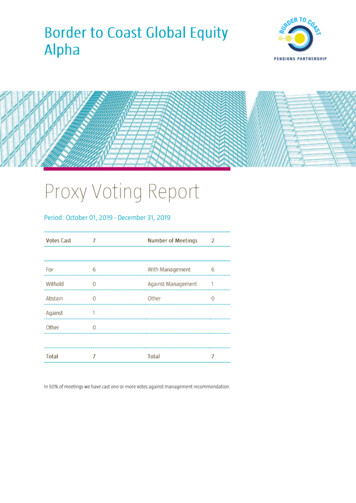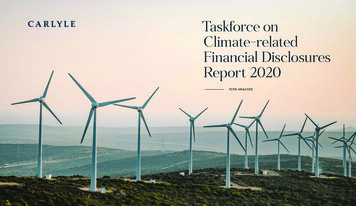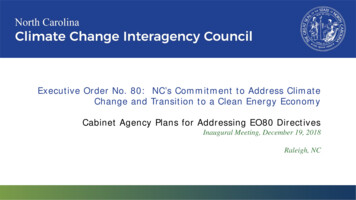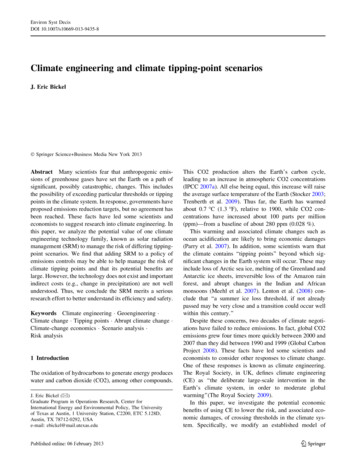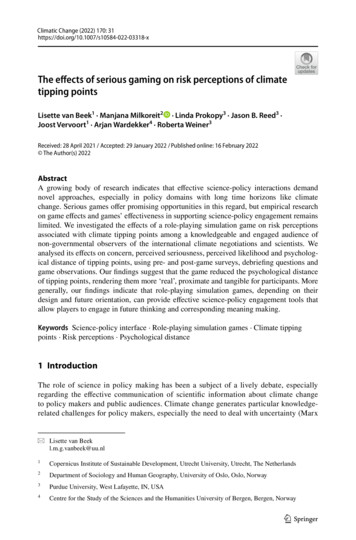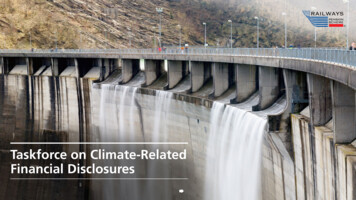
Transcription
Taskforce on Climate-RelatedFinancial Disclosures
MembersummaryClimatechangeClimategovernanceClimate risksin the schemeMetrics andtargetsGlossaryAppendicesContentsChair’s message to members. 31. About this report. 42. Summary for members. 53. Climate change and its relevance to pension schemes. 84. Climate governance at our Scheme. 125. Climate risks in the Scheme, impacts on strategy, and the actions we are taking. 266. Metrics, targets and the transition to Net Zero. 52Glossary. 62Appendix A: Index of statutory reporting requirements. 64Appendix B: Further information in relation to selected climate metrics. 68Appendix C: MSCI disclaimer. 70Taskforce on Climate-Related Financial Disclosurepage 2
Chair’smessageAbout nceClimate risksin the SchemeMetrics andtargetsGlossaryAppendicesChair’s message to membersClimate change is one of the most pressing issuesof our time. Climate science tells us there will becatastrophic implications for current and futuregenerations if we do not address this challenge in thecurrent decade. The physical effects of climate change,and the policy and technological measures introducedto mitigate climate-related damages, are likely to havefinancial consequences for investors. On behalf ofour members, we recognise and seek to address thefinancial risks posed by climate change, while alsoacknowledging our responsibilities towards the worldinto which our members retire.Railways Pension Trustee Company Limited (RPTCL),the corporate Trustee of the railways pensionschemes, is focussed on our mission to pay pensionssecurely, affordably, and sustainably. When it comesto climate-related risks, we have a duty to ensuregood governance of climate risks and to monitor thepotential impacts on investment returns, liabilities,and employer covenant.We are supported in this endeavour by our whollyowned subsidiary Railways Pension InvestmentsLimited (Railpen). Railpen’s purpose, governance, andoperating arrangements ensure a good degree ofalignment with the Trustee’s mission, giving us botha clear line of sight of our shared objectives.Taskforce on Climate-Related Financial DisclosureThe Trustee is supportive of the positive and proactivestance adopted by Railpen in relation to climatechange. Over the years this has included engagementwith policy makers, early adoption of climate scenarioanalysis, development of proprietary climate riskframeworks and tools, use of engagement and votingto encourage portfolio companies to set credibledecarbonisation plans, investment in renewable energyinfrastructure in the UK and, in 2021, publicationof a Net Zero Plan, one of the first of its kind inthe UK. These activities connect with the Trustee’supdated Investment Beliefs in which we record our“responsibility to make a Scheme assets resilient tosystemic threats and position portfolios for long-termopportunities.”We endorse the increased transparency broughtabout by investor requirements to report in line withthe recommendations of the Taskforce on Climaterelated Financial Disclosures (TCFD). We are pleased toshare our first official TCFD report with our membersand trust this gives confidence that RPTCL is bothmanaging climate-related risks, and contributing ourpart to a more sustainable future.Signed,Chris HannonChair of Trustees, RPTCLAt the time of drafting this report, the world is beset byuncertainty. Russia’s invasion of Ukraine, the challengesof emerging from COVID-19 and inflationarypressures on the cost of living have highlighted theclose links between energy security, affordability, andclimate change. Whilst the global response to thesefactors might contribute to short-term increases ingreenhouse gas (GHG) emissions, a transition to alow carbon economy remains essential for limitingharmful temperature rises in line with the ParisAgreement on climate change. The analytics in thisreport suggest we have a vested interest in supportinga lower temperature outcome, as this would benefit– economically as well as societally – the half a millionmembers on whose behalf we invest.page 3
Chair’smessageAbout nceClimate risksin the SchemeMetrics andtargetsGlossaryAppendices1. About this reportThe purpose of this report is to explain the governanceand actions taken by the Trustee in identifying,assessing and managing climate-related risks andopportunities. The report fulfils the requirements ofthe Occupational Pension Schemes (Climate ChangeGovernance and Reporting) Regulations 2021 (“theRegulations”), which are themselves designed toalign with the recommendations of the Taskforce onClimate-Related Financial Disclosures1.The Scheme in scope for this report is the RailwaysPension Scheme. The Railways Pension Scheme iscomprised of six parts (including defined benefit anddefined contribution arrangements) with over 100individual underlying sections2. As permitted by therelevant statutory guidance3, we have grouped definedbenefit sections for the purposes of climate strategydisclosure (including scenario analysis) and climatemetrics disclosure, since the sections have broadlysimilar characteristics.The TCFD Recommendations – and therefore theRegulations and associated statutory guidance – arestructured around four pillars:(i)Governance(ii) Strategy(iii) Risk Management, and(iv) Metrics & TargetsIn structuring our report we have found it expedient– in terms of the ease with which members couldengage with the report – not to structure the reportin a way that progresses sequentially from (i) to (iv).Instead, we have prepared our disclosure in such a wayas to maintain readability, though we provide an indexat the back of the document for those wishing to lookup particular statutory or TCFD reporting requirements.All data in this report is as of 31 December 2021 unlessotherwise noted.1https://www.fsb-tcfd.org2Please see the Annual Report and Accounts for more detailed information.3Governance and reporting of climate change risk: guidance for trustees of occupationalschemes”, Department for Work and Pensions, June 2021Taskforce on Climate-Related Financial DisclosureDay-to-day operation of the railways pension schemesis delegated to Railway Pension Investments Limited(Railpen), a subsidiary wholly owned by the Trustee.Railpen undertakes a significant amount of climaterelated activities on the Trustee’s behalf. This isreflected in the content of this report, which includesreferences to activities carried out both by the Trusteeand by Railpen.Further information in relation to Railpen’s approachto climate change can be found at railpen.com and inRailpen’s Net Zero Plan.1.1 Internal AuditWhilst not a mandatory requirement to seek assuranceover the TCFD report, Railpen’s Internal Audit teamwere engaged on the Trustee’s behalf to undertakework on the report prior to publication. This team isindependent, objective and has an extensive trackrecord in providing challenge and insights across thewider Railpen business, in conformance with theInternational Standards for the Professional Practice ofInternal Auditing (‘the Standards’) and the CharteredInstitute of Internal Audit’s guidance, ‘Effective InternalAudit in Financial Services’. An internal review of thisreport was chosen owing to the Internal Audit team’sextensive experience and the value that this would addto the process.The objective of this review was to provide assuranceover the Trustee’s TCFD report and an independent andobjective view on the process, content and statementsmade within the report. This was approached in twophases:nPhase 1 - review the draft TCFD report producedagainst the relevant guidance and requirementsto assess whether key reporting obligations havebeen met, andnPhase 2 - review a sample of assertions madewithin the report to evaluate the statements made.We reviewed the evidence the organisation holdsto support making these specific disclosures.Internal Audit found that the TCFD report was alignedto the statutory guidance and reporting requirementsand that for the sample of assertions tested that thesewere supported by clear evidence. The Internal Auditteam provided recommendations and enhancementsto the report to ensure that the requirements of thereport were met. They also provided challenge tostatements and disclosures made. Following productiveconversations, a number of recommendations wereraised, which have been applied within the final versionof the report.page 4
Chair’smessageAbout nceClimate risksin the SchemeMetrics andtargetsGlossaryAppendices2. Summary for membersClimate-related risks are financial risks. Over the longterm, companies, consumers, and the financial industryare likely to have to adapt to new and bold climatepolicies like carbon taxes, or adapt to the potentiallycatastrophic consequences of uncontrolled climatechange like sea level rises and increasingly frequentextreme weather, or a mixture of both.Whilst climate risk is likely to play out over manydecades to come, its effects are already evident bothin the dramatic and tragic weather events you mightsee on the news and, from time to time, in financialmarkets. There is some evidence that investors havedecided they have enough certainty about the futureevolution of, for example, energy policy that they havebegun to factor climate change issues into the waythey buy and sell financial assets. Attending to climaterisk is part and parcel of an investor’s ‘fiduciary duty’– the promise to act in the best interests of the personwhose money is being invested.Climate risks have the potential to affect almost everysector, region, and asset class, depending on how therisks play out. This makes climate risk a systemic risk,because its effects are likely to be felt by a large partof the financial system, rather than being localised toone or two areas. This means long-term investors likepension funds are unlikely to be able to completelyavoid climate risks by simply refusing to invest incertain sectors or countries.Taskforce on Climate-Related Financial DisclosureThe Trustee of the railways pension schemes treatsclimate risk with the seriousness it deserves. As weexplain in this, our first “TCFD4 Report”, the effectsof climate change could impact three key areas of apension scheme like ours:nThreats to the employer covenant: the pensionfund depends on ongoing contributions fromyour employer. If your employer turns out to bevulnerable to climate risks, this could threaten theemployer’s ability to contribute in the future.nThreats to scheme liabilities: the liabilities ofthe Scheme – the amount of cash we need topay out in pension benefits over a long period oftime – might be affected by climate change if, forexample, changes in weather patterns affect lifeexpectancy in the UK. This is very hard to predict,but is something pension funds need to monitor.nThreats to investment returns: a large part ofour members’ pension is provided by investmentreturns which are generated when Railpen, theScheme’s investment manager, invests money onyour behalf. Railpen is well-regarded for taking aleading approach to climate change issues, but thepossibility remains that climate-related risks couldaffect the amount of investment return generatedby investing the Scheme assets. Trustees and theirinvestment managers need to take account of this.The railways pension schemes are among thelargest and most complex schemes in the UK. Goodgovernance is essential when managing complexity.In 2021, we implemented a new Risk GovernanceFramework, updated our Investment Beliefs to explicitlyreference climate change, and established a TrusteeTraining programme that incorporates climate changetraining provided by Railpen and other climate experts.The Trustee’s ‘climate governance’ – the arrangementsin place to manage climate risk – also benefitsfrom Railpen’s Climate Working Group, which wasestablished in 2020 and made further strides in 2021.You can read much more about climate governance insection 4 of this report.4TCFD stands for Taskforce on Climate-related FinancialDisclosures, a body that has recommended a reportingstructure for organisations wanting to make a disclosureabout climate change. Starting in 2022, large UK pensionfunds are required to produce a report that complies withthe recommendations of the TCFD.page 5
Chair’smessageAbout thisreportMembersummaryClimatechangeWe have a framework for managing climate risks thatspans the climate-related threats to covenant, liabilities,and investment returns. As we explain later in thisreport this has in 2021 included a range of activities.A summary is included in the table to the right.CovenantClimategovernanceClimate risksin the SchemeMetrics andtargetsGlossaryAppendicesOn our behalf, Railpen has assessed and keeps under review the way in which climate risks affect and are affected by (i) UK policy, (ii) sectoralissues in the rail industry, and (iii) particular issues at individual employers. This provides the Trustee with a valuable assessment of climate risksto the Scheme’s employers.Whilst there are over 150 employers in the Scheme, around 75% of the Scheme assets relate to sections sponsored by government-linkedbodies including Network Rail and 27 train operating companies. These employers have been the focus of this year’s TCFD report.Railpen’s forward-thinking team co-authored an innovative industry guidance document this year, which supports others in analysing climaterisks in the context of an employer covenant5. You can read more about this in section 5.2.LiabilitiesTo improve our understanding of the sensitivity of the Scheme’s liabilities to climate risks, we undertook ‘climate scenario analysis’. This meanswe made assumptions about the ways in which climate change might play out over the long term, then considered the potential impacts tothe Scheme’s liabilities. In particular, we reviewed the impacts that climate change might have on life expectancy.While the results of the analysis suggested the impact of climate change on liabilities is likely to be relatively low, the relationship betweenclimate change and life expectancy is inherently unpredictable, so we will be monitoring this again in the future.We compared the impacts climate change might have on liabilities to the impacts it might have on investment returns. The results suggest thatclimate change might have a bigger impact on investment returns than on liabilities. You can read more about this in section 5.3.InvestmentsWorking on the Trustee’s behalf, Railpen incorporates climate risks and opportunities into the investment management process. Briefly put,Railpen aims to reduce climate-related risks, and identify climate-related opportunities, because it is likely that doing so would support theTrustee’s mission to pay pensions securely, affordably, and sustainably. This includes:nexcluding companies we think might face elevated risks of asset stranding, such as thermal coal and tar sands companiesnincorporating assessments of climate risk and net zero alignment into investment decisions using a framework and tool developed in-housenengaging companies and voting at company AGMs in a way to hold companies to account for the management of climate risks andthe transition to ‘net zero’noverseeing external fund managers to make sure they meet our own high standards on climate change issuesYou can read more about this in section 5.4.5Taskforce on Climate-Related Financial DisclosureEmployer Covenant Practitioners Association, “Reflecting climate change impact and risks in employer covenant assessments”page 6
Chair’smessageAbout thisreportMembersummaryWhilst this is the first year the Scheme has beenrequired to provide a carbon footprint, Railpen, as theScheme’s investment manager, has voluntarily discloseda carbon footprint for scheme assets every year since2015, as part of its status as a Montreal Carbon Pledgesignatory.In December 2021, the Scheme’s investment portfoliohad a carbon footprint of c63 tonnes of greenhousegases (GHGs) per million invested. This is significantlybelow the market average, because Railpen’s portfoliomanagers tend to invest in lower carbon companiesthan the average. The carbon footprint has decreasedby approximately 10% since December 2020.The Trustee has adopted climate target that, ifachieved, should put the Scheme on track to be ‘netzero’ by 2050 or sooner. ‘Net zero’ is a state in whichthe emissions created by the Scheme’s investmentsare very close to zero, and any leftover emissions areremoved from the atmosphere either by natural ortechnological means. The Scheme aims to halve itscarbon footprint by 2030, and to have reduced it by25-30% by 2025.A significant amount of the Scheme assets are investedin renewable energy and other sectors that couldbenefit from the UK’s transition to a greener economy.For example, the Scheme owns two large wind farms inScotland that produce enough energy to power around50,000 homes. Green investments can be attractiveto long-term investors like pension funds, providingthe price of the investment makes financial sense.The transition to ‘net zero’ could provide significantinvestment opportunities, and the Scheme’s investmentmanager continues to locate sustainableTaskforce on Climate-Related Financial DisclosureClimatechangeClimategovernanceClimate risksin the SchemeMetrics andtargetsGlossaryAppendicesinvestments that match the needs of our members.In producing this TCFD report, we have provided asmuch climate-related information as we have beenable to source, but unfortunately investors are stillsome way away from having perfect information onclimate risk. For example, reporting annual GHG data isnot compulsory in most markets, meaning that plentyof companies do not tell investors the amount of GHGsemitted each year. It is not always possible to estimatea company’s GHG emissions to plug gaps in the data.Issues like these mean that the carbon footprint datawe have provided in this report covers 57% of thedefined benefit scheme’s investments (62% of thedefined contribution arrangements), rather than thewhole lot. The Trustee and Railpen are members ofseveral industry initiatives that support improvementsin climate-related information (see section 6.4.3). Moreinformation should improve our ability to take actionon climate risk, and keep our stakeholders betterinformed via the annual TCFD report.We recognise that many readers may be encounteringthis topic for the first time, and we have tried tomake this report as readable as possible to members,Writing a report on climate change, and its complexconnections with pension investing, cannot bedone without having to resort to concepts that aresomewhat technical in nature and unfamiliar to many.We have tried to avoid jargon where we can, andwe have provided a glossary of key terms to aid thereport’s readability.Members who wish to contact the Scheme or learnmore about the Scheme’s approach to climate changeare encouraged to email contactus@railpen.compage 7
Chair’smessageAbout nceClimate risksin the SchemeMetrics andtargetsGlossaryAppendices3. Climate change and its relevance to pension schemesFigure 3.1.1: Historical average surface temperaturerise for the Earth; Source: NASAGlobal land-ocean temperature indexData source: NASA’s Goddard Institute for Space Studies (GISS)Credit: NASA/GISSTemperature Anomaly 0The impacts of human-induced climate change arenot a phenomenon for tomorrow - they are visibletoday. Examples include wildfires in Australia andCalifornia, US hurricanes Katrina, Ida and Sandy, floodsin Europe, UK and Asia, and increasing devastationin the global south. These events have resulted notonly in devastation for current and future generationsand their families, but also in cumulative historicalcosts of more than 1 trillion to the global financialsystem6. The future economic impact of climate changecontinues to be highly researched, with a 2021 studyfrom University College London indicating that, by2100, global GDP could be 37% lower when takingthe effects of climate change on economic growthinto account7.There is clear evidence that the pace of warming inrecent decades has increased. The Earth’s average landand ocean surface temperature in 2021 was 0.84 Cabove the 20th century average, the 45th consecutiveannual rise since 1977. The years 2013-2021 rank asthe warmest years on record.Figure 3.1.3: Historical CO2 levels from 800,000 yearsago to present; Source: NASA .Proxy (indirect) measurementsData source: Reconstruction from ice coresCredit: NOAA420Figure 3.1.2: Historical CO2 levels from 2005 topresent; Source: NASA8.Current380Direct measurements: 2005-presentData source: Monthly measurements (average seasonal cycle removed)Credit: NOAACO2 (parts per million)The overwhelming scientific consensus is that theEarth’s average surface temperature has risen byapproximately 1 C since pre-industrial times and thatthis temperature rise has been caused by humanactivity, particularly the consumption of fossil fuelsand changing how we use the land.Anthropogenic climate change is linked to morefrequent and severe extreme weather events, theimpacts of which are both societal and economic.Climate change is one of the greatest challenges ofthe present generation and, in the past few decades,has caused irreversible damage to our planet and wayof life.CO2 (parts per million)3.1 Climate change summary3401950Highest historial CO2 ousands of years before today (0 1950)390380200720102013201620192022YearYearAnnual meanLowess smoothingTaskforce on Climate-Related Financial Disclosure6Source: Reuters, on climate change companies-disclosure-idUSKCN1T50CF.7Source: University College, London -thought8Source: NASA; e/9Source: NASA; e/page 8
Chair’smessageAbout nceClimate risksin the SchemeMetrics andtargetsGlossaryAppendicesFigure 3.1.4: Decline in annual minimum Arctic sea ice;Source: NASA10Annual September minimum extentData source: Satellite observationsCredit: NSIDC/NASARate of change13.0PHARGWREDRAmillion square km7.0percent per decade6.05.04.019841992200020082016YearThe Intergovernmental Panel on Climate Change (IPCC)identified, in their latest climate science synthesis reportthat it is now certain global temperatures will continueto increase until at least 205011.Arctic sea ice reaches its minimum each September.The ice is now declining at a rate of 13% per decade,relative to the 1981 to 2010 average. Figure 3.1.4shows the annual Arctic sea ice minimum eachSeptember since 1979, derived from satelliteobservations.Taskforce on Climate-Related Financial DisclosureThe evidence from climate science suggests that, overthe coming decades, the impacts of global climatechange will become worse as a result of historichuman-induced GHG emissions. The extent of futureclimate change impacts will depend on our success incontrolling global emissions over the coming decades.The average surface temperature in the UK has risen by1.2 C since pre-industrial times, and further warmingis predicted under all decarbonisation pathways set outby the IPCC. Whilst the Paris Agreement on ClimateChange sets out an aim to limit warming to 1.5 C,current trends imply that warming up to 4 C is notimplausible.3.2 Physical, Transition, and LitigationRisksIt has become common to follow the TCFD in subdividing climate-related risks into two major categories:nphysical risks – those related to the physicalimpacts of climate change, andntransition risks - those related to the transition to alower-carbon economy.10Source: NASA; e/11Source: IPCC; https://www.ipcc.ch/sr15/chapter/spm/page 9
Chair’smessageAbout nceClimate risksin the SchemeFigure 3.2.1: Definition of physical and transition risksTransition risksPhysical risks are those that pertain to the physicalimpacts that occur as the global average temperaturerises. For example, the rise in sea levels could haveimpacts such as flooding and mass migration.Transition risks arise as we seek to realign oureconomic system towards low-carbon, climateresilient solutions.Physical risks have direct and indirect financialimplications for companies, including damage toassets, impacts from supply chain disruption, wateravailability, sourcing, and quality, food security,extreme warming affecting premises, operations,supply chain, transport needs, and employee safety.GlossaryAppendicesFigure 3.2.2: Global distribution of areas at high risk of floods, sea level rises, heat stress, water stress, wildfiresand hurricanes. Source: New York Times12.Physical risksPhysical risks event-driven (acute) or relate to longerterm shifts (chronic) in climate patterns.Metrics andtargetsTransitioning to a lower-carbon economy mayentail extensive policy, legal, technology, and marketchanges to address mitigation and adaptationrequirements related to climate change. Forexample, this includes policies to phase-in (EV),phase-out (coal), subsidies, carbon tax. It alsoincludes development of specific low carbon energytechnologies.Depending on the nature, speed, and focus ofthese changes, transition risks pos
report was chosen owing to the Internal Audit team's extensive experience and the value that this would add to the process. The objective of this review was to provide assurance over the Trustee's TCFD report and an independent and objective view on the process, content and statements made within the report. This was approached in two phases:




